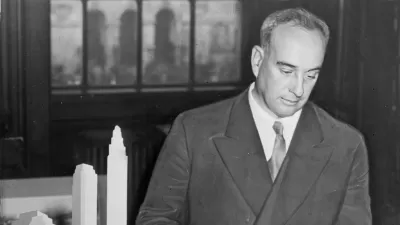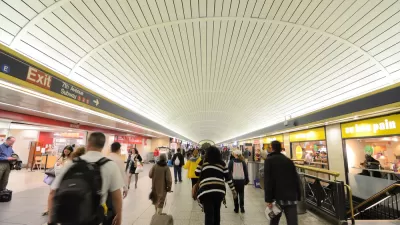When the railroad was the primary means of interstate travel, America's cities relied on their train stations to provide grand first impressions to travelers. As transit ridership soars, a bevy of new stations are being designed as civic centerpieces
Will Doig looks at a selection of new stations being built in New York, San Francisco, and elsewhere, and sees signs that cities are again lavishing money on their transportation hubs, expanding on the role of the grand station houses of the past to provide "transit environments" that reflect "today's urban ideals". Doig focuses his attention on Minneapolis's new hub, called the Interchange, which architect Peter Cavaluzzi, principal at EE&K, describes as functioning, "in the new wave of transit hubs where we're trying to blend transit and culture."
So, what is a "transit environment"? "First off, it's not just trains," writes Doig. "It's
heavy rail, light rail, buses, streetcars, subways, bicycles,
pedestrians, all integrated into a single multi-modal hub. Second, it's
an activated space, with shops and restaurants (not just kiosks and food
courts, but stores and restaurants you'd want to hang out in), live
performances, art, parks - a true public gathering space. Finally, it's
integrated into the city, less a soaring monument to transportation than
a celebration of urban life - and in the more ambitious efforts, a
small city in itself."
However exciting the premise of these "magnificent public gathering spots" based around the clamor for increased transit options represents, Doig questions whether the expanded role envisioned for such facilities could come at the expense of their central function, "providing the best possible ways to get from one place to another."
FULL STORY: Commuting to Disneyland

Alabama: Trump Terminates Settlements for Black Communities Harmed By Raw Sewage
Trump deemed the landmark civil rights agreement “illegal DEI and environmental justice policy.”

Study: Maui’s Plan to Convert Vacation Rentals to Long-Term Housing Could Cause Nearly $1 Billion Economic Loss
The plan would reduce visitor accommodation by 25% resulting in 1,900 jobs lost.

Planetizen Federal Action Tracker
A weekly monitor of how Trump’s orders and actions are impacting planners and planning in America.

Waymo Gets Permission to Map SF’s Market Street
If allowed to operate on the traffic-restricted street, Waymo’s autonomous taxis would have a leg up over ride-hailing competitors — and counter the city’s efforts to grow bike and pedestrian on the thoroughfare.

Parklet Symposium Highlights the Success of Shared Spaces
Parklets got a boost during the Covid-19 pandemic, when the concept was translated to outdoor dining programs that offered restaurants a lifeline during the shutdown.

Federal Homelessness Agency Places Entire Staff on Leave
The U.S. Interagency Council on Homelessness is the only federal agency dedicated to preventing and ending homelessness.
Urban Design for Planners 1: Software Tools
This six-course series explores essential urban design concepts using open source software and equips planners with the tools they need to participate fully in the urban design process.
Planning for Universal Design
Learn the tools for implementing Universal Design in planning regulations.
Caltrans
Smith Gee Studio
Institute for Housing and Urban Development Studies (IHS)
City of Grandview
Harvard GSD Executive Education
Toledo-Lucas County Plan Commissions
Salt Lake City
NYU Wagner Graduate School of Public Service




























